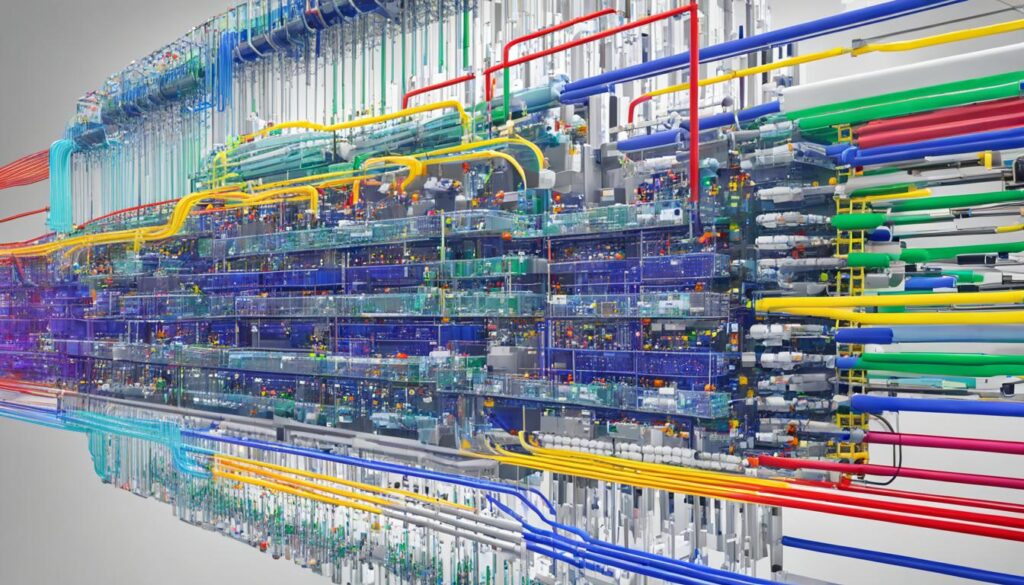Welcome to our comprehensive guide on DataFlow Modelling in Verilog! In this series, we will explore the concept of DataFlow Modelling and its significance in efficient digital design and verification. Verilog, a hardware description language commonly used in the design and verification of digital circuits, provides a powerful framework for implementing DataFlow Modelling techniques.
DataFlow Modelling, as the name suggests, focuses on modeling the flow of data within a digital circuit. By representing the circuit’s behavior in terms of data dependencies, DataFlow Modelling enables us to design and simulate complex systems with ease. It offers a paradigm shift from traditional procedural models, allowing for more efficient and reliable circuit simulations.
Throughout this series, we will dive into the fundamentals of DataFlow Modelling, covering topics such as understanding its principles, designing circuits using DataFlow Modelling, and exploring its benefits. We will also discuss advanced techniques and strategies that can further enhance the efficiency of DataFlow Modelling in Verilog.
Verifying the correctness and reliability of DataFlow Models is crucial in ensuring robust digital circuit designs. We will delve into various methodologies and tools that can aid in the verification process, ensuring the accuracy of the models.
By the end of this series, you will have a comprehensive understanding of DataFlow Modelling in Verilog and how it can revolutionize your digital design and verification workflows. So let’s dive in and explore the world of DataFlow Modelling in Verilog!
Table of Contents
Understanding DataFlow Modelling
In this section, we will explore the fundamentals of DataFlow Modelling and its significance in digital circuit simulations. Understanding DataFlow Modelling is crucial for engineers and designers working with Verilog to create efficient and reliable circuits.
DataFlow Modelling is a technique used in digital design where the behavior of a circuit is described based on the flow of data through it. It represents the dependencies between different signals, enabling designers to express the functionality of the circuit in a concise and intuitive manner.
One of the key principles of DataFlow Modelling is that the output of a module depends solely on the values of its input signals. This means that whenever the input signals change, the module will compute and update its output accordingly. This behavior allows for efficient simulation of digital circuits, as only the affected modules need to be updated when there is a change in the input signals.
Advantages of DataFlow Modelling
DataFlow Modelling offers several advantages over other modeling techniques. Firstly, it provides a clear representation of the data dependencies within a circuit, making it easier to verify and debug designs. Engineers can easily trace the flow of data through the modules, identify bottlenecks, and optimize the design accordingly.
Secondly, DataFlow Modelling is highly parallelizable. Since each module in a design evaluates independently based on the input signals, multiple modules can be evaluated simultaneously, allowing for efficient utilization of resources and faster simulation times.
Furthermore, DataFlow Modelling promotes modularity and reusability. Engineers can easily create reusable modules that can be integrated into larger designs, saving time and effort in the development process. It also allows for incremental design updates, as changes in one module do not affect the rest of the design as long as the input-output interfaces remain consistent.
Applications of DataFlow Modelling
DataFlow Modelling is widely used in various areas of digital circuit design, including microprocessor design, FPGA programming, and ASIC design. It is particularly effective for complex designs with multiple interconnected modules, as it simplifies the representation and analysis of the circuit functionality.
With DataFlow Modelling, engineers can accurately simulate the behavior of the circuit, identify potential issues, and optimize the design before final implementation. This ensures that the resulting circuit meets the desired specifications and performs as expected in real-world scenarios.
Next, we will dive into the process of designing circuits using DataFlow Modelling in Verilog, discussing the key steps involved and providing practical examples to illustrate the concept.
Designing with DataFlow Modeling
Designing circuits using DataFlow Modeling in Verilog involves a systematic approach to create efficient and reliable digital designs. In this section, we will explore the key steps involved in the process and provide practical examples to illustrate the concept.
Step 1: Problem Definition
The first step in designing with DataFlow Modeling is clearly defining the problem at hand. This involves understanding the desired functionality of the circuit and identifying the inputs, outputs, and any specific constraints or requirements.
Step 2: Design Partitioning
After defining the problem, the next step is to partition the design into smaller, manageable modules. This helps in maintaining a modular design approach and enables efficient testing and verification of individual components.
Step 3: Modeling the DataFlow
The core of DataFlow Modeling lies in defining the flow of data within the circuit. This is accomplished by specifying the input and output signals, as well as the operations and computations that connect them. Verilog provides a rich set of constructs and operators to facilitate this process.
Step 4: Verification and Testing
Once the DataFlow Model is created, it is important to thoroughly test and verify its functionality. This involves designing test cases, simulating the circuit, and analyzing the results to ensure that it behaves as expected.
Step 5: Optimization and Refinement
As the design progresses, it’s common to identify areas for optimization and refinement. This may involve improving performance, reducing power consumption, or enhancing the overall design quality. Iterative refinement is key to achieving an optimal and robust circuit design.
Step 6: Integration and Synthesis
Once the individual modules are verified and optimized, the next step is to integrate them into a complete circuit design. This involves connecting the modules together, ensuring proper inter-module communication, and generating a synthesized netlist that can be used for fabrication.
By following these steps, designers can effectively harness the power of DataFlow Modeling in Verilog to create intricate and efficient digital circuits. Let’s now explore practical examples to further illustrate the concept.
Benefits of DataFlow Modelling
DataFlow Modelling offers several key benefits when used in Verilog. By incorporating this methodology into digital design and verification, engineers can optimize simulation performance, streamline development processes, and improve the reusability of their designs.
Improved Simulation Performance
One of the primary advantages of DataFlow Modelling is its ability to enhance simulation performance. By representing designs as interconnected data flows, rather than explicit procedural sequences, Verilog models can be optimized for speed. This allows for faster and more efficient simulations, enabling engineers to quickly evaluate the behavior and functionality of their designs.
Reduced Development Time
DataFlow Modelling enables a more streamlined approach to digital design. By focusing on the flow of data through the circuit, engineers can create modular and scalable designs. This means that individual components can be developed and tested independently, resulting in shorter development cycles. Additionally, the reusability of DataFlow models allows designers to leverage existing components, further reducing development time.
Enhanced Reusability
Another significant advantage of DataFlow Modelling is its inherent reusability. By creating modular designs with well-defined data flow interfaces, engineers can easily reuse and integrate components across multiple projects. This not only saves time but also ensures consistent and reliable designs. The reusability of DataFlow models promotes a more efficient design process and facilitates collaboration among development teams.
Overall, DataFlow Modelling in Verilog offers numerous benefits that can greatly improve digital design and verification. The improved simulation performance, reduced development time, and enhanced reusability all contribute to more efficient and reliable designs, enabling engineers to meet the ever-increasing demands of modern circuit design.
Advanced Techniques in DataFlow Modelling
Building upon the fundamental principles of DataFlow Modelling in Verilog, there are several advanced techniques and strategies that can further enhance its efficiency and effectiveness. These techniques allow us to optimize designs, improve performance, and streamline the development process.
Pipelining
One of the key advanced techniques in DataFlow Modelling is pipelining. Pipelining involves breaking down a complex operation into smaller stages and executing them in parallel. By dividing the operation into sequential steps and introducing pipeline registers, we can achieve higher throughput and reduce the overall latency of the system.
Parallelization
Parallelization is another powerful technique that can be applied in DataFlow Modelling to leverage the capabilities of modern hardware architectures. By identifying independent tasks or operations within a design, we can distribute them across multiple processing units or cores, allowing for concurrent execution and accelerating overall performance.
Optimization
Optimization plays a crucial role in enhancing the efficiency of DataFlow Modelling. This involves fine-tuning the design to minimize area, power consumption, and timing constraints while maintaining the desired functionality. Techniques such as logic restructuring, resource sharing, and gate-level optimizations can significantly improve the performance and reduce the complexity of the design.

By incorporating these advanced techniques into the DataFlow Modelling process, we can unlock the full potential of Verilog and enable the development of highly efficient and optimized digital designs. The following table summarizes the key features and benefits of each technique:
| Technique | Key Features | Benefits |
|---|---|---|
| Pipelining | – Divide operations into stages – Introduce pipeline registers |
– Higher throughput – Reduced latency |
| Parallelization | – Identify independent tasks – Distribute across multiple processing units |
– Concurrent execution – Improved performance |
| Optimization | – Fine-tuning the design – Logic restructuring – Resource sharing |
– Minimized area, power, and timing constraints – Improved efficiency |
These advanced techniques contribute to the continuous evolution of DataFlow Modelling, enabling designers to achieve higher performance, greater efficiency, and improved functionality in their digital designs. By mastering these techniques, we can further push the boundaries of Verilog and unlock the full potential of DataFlow Modelling.
Verifying DataFlow Models
Ensuring the correctness and reliability of DataFlow Models is crucial in digital design and verification. The verification process helps identify and rectify any issues or errors in the design, ensuring that the final implementation meets the desired specifications.
Various methodologies and tools are available to aid in the verification of DataFlow Models. Let’s explore some popular approaches:
Simulation-based Verification
Simulation-based verification involves creating testbenches to simulate the behavior of the DataFlow Models. By comparing the expected outputs with the simulated results, any discrepancies or errors are detected and corrected. This process provides valuable insights into the functionality and performance of the design.
Formal Verification
Formal verification techniques use mathematical algorithms and logical reasoning to rigorously analyze the DataFlow Models. By mathematically verifying the correctness of the design, formal verification ensures that the model meets specified properties and eliminates potential design flaws.
Model Checking
Model checking is a systematic approach that exhaustively explores the behavior of the DataFlow Models to identify potential errors or violations in the design. By systematically analyzing the state space of the model, model checking techniques ensure the absence of any undesired behaviors.
Table: Comparison of Verification Methodologies
| Verification Methodology | Advantages | Disadvantages |
|---|---|---|
| Simulation-based Verification | 1. Easy to implement 2. Provides insight into functional behavior |
1. Limited coverage 2. Time-consuming for large designs |
| Formal Verification | 1. Rigorous analysis of correctness 2. Eliminates design flaws |
1. Complex and resource-intensive 2. Requires expertise in formal methods |
| Model Checking | 1. Thorough exploration of model behavior 2. Identifies potential errors or violations |
1. State space explosion 2. May not scale well for large designs |
It is important to select the appropriate verification methodology based on the complexity of the DataFlow Models and the verification goals. Combining multiple methodologies can provide comprehensive verification coverage and increase the confidence in the design’s correctness and reliability.

By employing effective verification methodologies, designers can confidently validate their DataFlow Models, ensuring optimal performance, reliability, and functionality of the designed circuits.
Conclusion
In conclusion, we have explored the essentials of DataFlow Modelling in Verilog and its significance in digital design and verification. DataFlow Modelling is a powerful technique that allows designers to express the behavior of their digital circuits in a concise and efficient manner.
By using DataFlow Modelling techniques, designers can improve the performance of circuit simulations, leading to more efficient and reliable designs. The modular and hierarchical nature of DataFlow Modelling makes it easier to manage complex circuits, enabling better design reuse and reducing development time.
Furthermore, DataFlow Modelling allows for easy integration of advanced techniques such as pipelining and parallelization, leading to even higher performance and optimization. The importance of verifying DataFlow Models cannot be overstated, and there are various methodologies and tools available to ensure the correctness and reliability of the designs.
In summary, DataFlow Modelling in Verilog offers numerous benefits and is an essential technique for digital design and verification. By incorporating DataFlow Modelling into their workflow, designers can achieve more efficient and reliable circuit simulations, leading to better overall designs.

